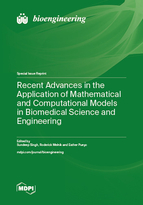Recent Advances in the Application of Mathematical and Computational Models in Biomedical Science and Engineering
A special issue of Bioengineering (ISSN 2306-5354). This special issue belongs to the section "Regenerative Engineering".
Deadline for manuscript submissions: closed (30 June 2023) | Viewed by 18326
Special Issue Editors
Interests: thermo-fluids; mathematical modeling & simulations; computational fluid dynamics and heat transfer; biomedical engineering
Special Issues, Collections and Topics in MDPI journals
Interests: coupled multiscale problems in bioengineering and biomedicine; biomaterials, bionano systems; inverse problems; modelling dynamic diseases and pain; brain processes and brain models; geometry-based techniques such as 3D printing; statistical learning, human factor, control systems
Special Issues, Collections and Topics in MDPI journals
Special Issue Information
Dear Colleagues,
Mathematical modeling in biomedical engineering plays a vital role in understanding complex multidisciplinary interactions and processes at the organ, tissue and cellular scales. Mathematical modeling serves as a low-cost but powerful alternative for optimizing, predicting, and improving existing healthcare protocols, systems and equipment. This Special Issue aims at collecting original research articles related to the advancement and development of novel mathematical models broadly applied across a wide range of biomedical engineering and medical physics, including diagnostic, therapeutic, imaging, and interventional applications. Review articles pertaining to the overall scope of this issue are also welcome.
Topics of particular interest include, but are not limited to:
- coupled multiphysics and multiscale models in bioengineering and biomedicine
- bioheat models and thermography
- models for cancer theranostics
- patient-specific models
- dynamic and network models (e.g., regulatory, metabolic, brain networks, etc.)
- machine learning and multiscale modeling in the biological, biomedical, and behavioral sciences
- synthetic biology and its applications
- mathematical approaches into the regenerative medicine
- hemodynamics and drug delivery models
- computational neuroscience and neuroengineering, data-driven approaches in multidisciplinary neuroscience
- numerical methods and algorithms in the biomedical engineering
- computational and systems biology
- computational biomechanics
- reduced-order models
- biomedical simulation and high-performance computing
Dr. Sundeep Singh
Prof. Dr. Roderick Melnik
Dr. Esther Pueyo
Guest Editors
Manuscript Submission Information
Manuscripts should be submitted online at www.mdpi.com by registering and logging in to this website. Once you are registered, click here to go to the submission form. Manuscripts can be submitted until the deadline. All submissions that pass pre-check are peer-reviewed. Accepted papers will be published continuously in the journal (as soon as accepted) and will be listed together on the special issue website. Research articles, review articles as well as short communications are invited. For planned papers, a title and short abstract (about 100 words) can be sent to the Editorial Office for announcement on this website.
Submitted manuscripts should not have been published previously, nor be under consideration for publication elsewhere (except conference proceedings papers). All manuscripts are thoroughly refereed through a single-blind peer-review process. A guide for authors and other relevant information for submission of manuscripts is available on the Instructions for Authors page. Bioengineering is an international peer-reviewed open access monthly journal published by MDPI.
Please visit the Instructions for Authors page before submitting a manuscript. The Article Processing Charge (APC) for publication in this open access journal is 2700 CHF (Swiss Francs). Submitted papers should be well formatted and use good English. Authors may use MDPI's English editing service prior to publication or during author revisions.
Keywords
- modeling and simulation
- biomedical engineering
- medical physics
- multiphysics and multiscale models
- biomedical therapy
- neurotechnology
- regenerative medicine
- drug delivery
- data-driven models
- machine learning
- patient-specific models









